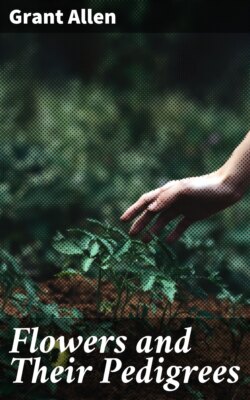Читать книгу Flowers and Their Pedigrees - Allen Grant - Страница 6
INTRODUCTORY.
ОглавлениеOur beautiful green England is carpeted, more than any other country in the world, perhaps, save only Switzerland and a few other mountain lands, with a perpetual sward of vivid verdure, interspersed with innumerable colours of daisies, and buttercups, and meadow-sweet, and harebells, and broader patches of purple heather. It is usual to speak of tropical vegetation, indeed, with a certain forced ecstasy of language; but those who know the tropics best, know that, though you may find a few exceptionally large and brilliant blossoms here and there under the breadth and shade of equatorial forests, the prevailing tone is one of monotonous dry greenery; and there is nothing anywhere in very southern climes to compare, as to mass of colour, with our Scotch hill-sides, our English gorse-clad commons, or our beautiful dappled meadows and cornfields, all aglow with the infinite wealth of poppies, bluebottles, foxgloves, ox-eye daisies, and purple fritillaries. The Alps alone can equal the brilliant colouring of our own native British flora. Poor as it is in number of species—a mere isolated fragment of the wider European groups—it can fearlessly challenge the rest of the whole world in general mingled effect of gaiety and luxuriance.
Now, every one of these English plants and weeds has a long and eventful story of its own. In the days before the illuminating doctrine of evolution had been preached, all we could say about them was that they possessed such and such a shape, and size, and colour: and if we had been asked why they were not rounder or bigger or bluer than they actually are, we could have given no sufficient reason, except that they were made so. But since the great principle of descent with modification has reduced the science of life from chaos to rational order, we are able to do much more than that. We can now answer confidently: Such and such a plant is what it is in virtue of such and such ancestral conditions, and it has been altered thus and thus by these and those variations in habit or environment. Every plant or animal, therefore, becomes for us a puzzle to be explained, a problem to be solved, a hieroglyphic inscription to be carefully deciphered. In the following pages, I have taken some half-dozen of familiar English weeds or flowers, and tried thus to make them yield up the secret of their own origin. Each of them is ultimately descended from the common central ancestor of the entire flowering group of plants; and each of them has acquired every new diversity of structure or appearance for some definite and useful purpose. As a rule, traces of all the various stages through which every species has passed are still visibly imprinted upon the very face of the existing forms: and one only requires a little care and ingenuity, a little use of comparison and analogy, to unravel by their own aid the story of their own remoter pedigree. This is the method which I have here followed in the papers that deal with the various modifications of the daisy, of the grasses, of the lilies, of the strawberry, and of the whole rose family.
Again, not only has each English plant a general history as a species, but it has also a separate history as a member of the British flora. Besides the question how any particular flower or fruit came to exist at all, we have to account for the question how it came to exist here and now in this, that, or the other part of the British Islands. For, of course, all plants are not to be found in all parts of the world alike, and their distribution over its surface has to be explained on historical grounds just as a future ethnologist would have to explain the occurrence of isolated French communities in Lower Canada and Mauritius, of African negroes in Jamaica and Brazil, or of Chinese coolies in San Francisco and the Australian colonies. In this respect, our English plants open out a series of interesting problems for the botanical researcher; because we happen to possess a very mixed and fragmentary flora, made up to a great extent of waifs and strays from at least three large distinct continental groups, besides several casual colonists. Thus while at Killarney we get a few rare Spanish or Portuguese types, in Caithness and the Highlands we get a few rare Alpine or Arctic types: and while in Norfolk and Suffolk we find some central European stragglers, the ponds of the Hebrides are actually occupied by at least one American pond-weed, its seeds having been wafted over by westerly breezes, or carried unconsciously by water-birds in the mud and ooze which clung accidentally to their webbed feet. Moreover, we know that at no very remote period, geologically speaking, Britain was covered by a single great sheet of glaciers, like that which now covers almost all Greenland: and we may therefore conclude with certainty that every plant at present in the country has entered it from one quarter and another at a date posterior to that great lifeless epoch. This, then, gives rise to a second set of problems, the problems connected with the presence in England of certain stray local types, Alpine or Arctic, Southern or Transatlantic, European or Asiatic. Questions of this sort I have raised and endeavoured to answer with regard to two rare English plants in the papers on the hairy spurge and the mountain tulip.
In short, these little essays deal, first with the evolution of certain plant types in general; and secondly with their presence as naturalised citizens of our own restricted petty insular floral commonwealth.
